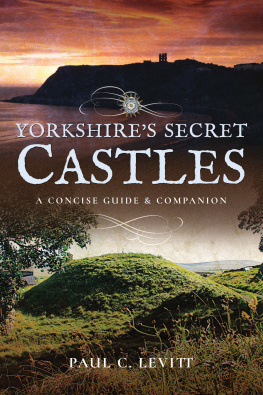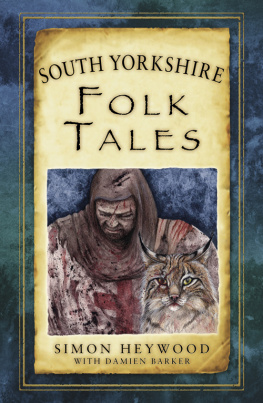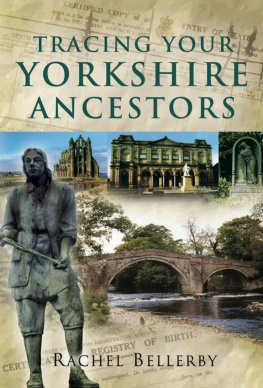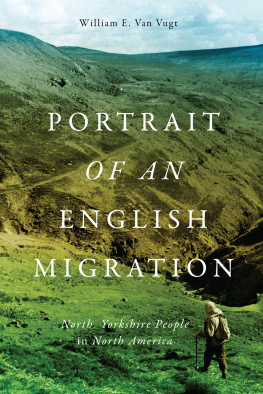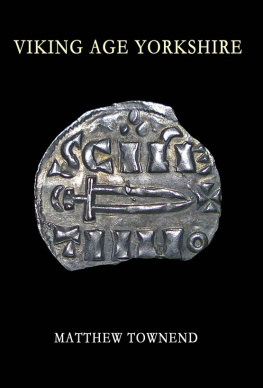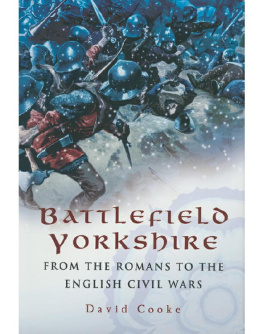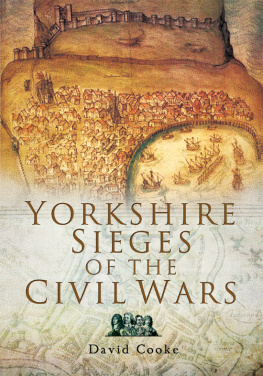Pagebreaks of the print ersion

Yorkshire
Yorkshire
A Story of Invasion, Uprising and Conflict
Paul C. Levitt

First published in Great Britain in 2019 by
Pen & Sword History
An imprint of
Pen & Sword Books Ltd
Yorkshire - Philadelphia
Copyright Paul C. Levitt, 2019
ISBN: 978 1 52675 255 0
eISBN: 978 1 52675 256 7
Mobi ISBN: 978 1 52675 257 4
The right of Paul C. Levitt to be identified as Author of this work has been asserted by him in accordance with the Copyright, Designs and Patents Act 1988.
A CIP catalogue record for this book is available from the British Library.
All rights reserved. No part of this book may be reproduced or transmitted in any form or by any means, electronic or mechanical including photocopying, recording or by any information storage and retrieval system, without permission from the Publisher in writing.
Pen & Sword Books Ltd incorporates the Imprints of Pen & Sword Books Archaeology, Atlas, Aviation, Battleground, Discovery, Family History, History, Maritime, Military, Naval, Politics, Railways, Select, Transport, True Crime, Fiction, Frontline Books, Leo Cooper, Praetorian Press, Seaforth Publishing, Wharncliffe and White Owl.
For a complete list of Pen & Sword titles please contact
PEN & SWORD BOOKS LIMITED
47 Church Street, Barnsley, South Yorkshire, S70 2AS, England
E-mail:
Website: www.pen-and-sword.co.uk
or
PEN AND SWORD BOOKS
1950 Lawrence Rd, Havertown, PA 19083, USA
E-mail:
Website: www.penandswordbooks.com
Preface
T hrow open any book on English history and Yorkshire will inevitably be mentioned. Kings of England came here on their way to conduct military campaigns against the Scots and to put down rebellions and punish unruly barons. They came to York the most important city in the north of the country since Roman times to sign treaties and perform other royal duties. But in earlier times, invaders came because they prized the fertile land that later became Yorkshire. Some arrived to plunder what riches they could find and extort huge payments in silver that rulers were ill placed to afford. Others came to conquer and rule over the land until they too became part of it. This is a story about Yorkshire and the people who came here throughout the ages. Many would settle and become our ancestors.
While writing this book, a pattern emerged that suggested a different title from the one originally intended. And so the working title of Yorkshire A Journey Through Time was changed to what you now see. It suggests a past punctuated by wars, upheaval and revolts most of which were put down with violence. This may seem a little exaggerated and unfair at first, but in his much acclaimed work, The Ascent of Man, the British mathematician, historian and author, Jacob Bronowski, offered a plausible explanation, namely, that the greater the distance between a people and government, or centre of power, the greater the chance that things would fall apart. This had been the chief cause of the collapse of vast and mighty empires throughout history, he pointed out. Bronowski, who lectured at University College Hull, went on to say that the distance between the above entities could only be closed if knowledge resides in the homes and heads of people with no ambition to control others, as opposed to residing in the isolated seats of power. Were these principles at work in a Yorkshire that was by the standards of the past greatly removed from the seat of central government and power? Is this why military intervention in the north was inevitable at some stage in history?
Another pertinent observation made by Bronowski was that history itself is not simply a sequence of events that occur, but rather the actions of people. Not just people remembering their past, but people acting and living the past in the present. He held that history is the instant act of decision that crystallises all the knowledge that has been learned since man began. So, using the notion that Yorkshire people merely did what they and their forefathers had been pre-programmed to do, including rebelling against any and every form of authority that was not home-grown, brings me to another interesting point. A term still uttered in these parts is Yorkshire grit. Surely this term arose for a reason? In my long experience I have never heard anyone talk about any other kind of grit and wondered how long the term had been in use. I was mildly surprised to find that grit as a personality trait is a whole area of study in the field of psychology and has been since at least 1892. It seems the qualities it suggests, namely, those akin to spirit, firmness of character, pluck, hardiness, resilience, persistence, tenacity call it what you will have been valued at least since the time of the Greek philosopher Aristotle (384322 bc). It even turns out that grit is a better predictor of achievement than IQ because grit helps to overcome challenges and setbacks (Duckworth 2007). Interestingly, a large study of twins measuring both conscientiousness and grit found that they had a genetic correlation (Rimfeld et al 2016). It is not surprising that this theory is contentious and the research and arguments will continue, but I for one think it feasible that grit is something that is impressed upon people from an early age by parents who themselves faced adversity in various ways. Thus this notion of grittiness and attitude to life may have been passed down from generation to generation up to the present day. Considering Yorkshires turbulent history, it also seems reasonable to assume that this might indeed be how the term originated. Grit certainly now appears to be recognised by the scientific community as an equaliser that acts as a driving force to override any other potential inequalities. And I would not discount it as being linked in some way to Yorkshires challenging past.
Acknowledgements
A s with my previous book titled Yorkshires Secret Castles, I am indebted to my talented artist friend, Andreas Renou, for reuse of his impression of the early Norman earth and timber fortress at Skipsea. My gratitude is also extended to Dennis Bromage, whose landscape images grace both the cover and the inside pages of this book. Furthermore, I would like to thank BAE Systems for kind permission to use the Blackburn B2 and Buccaneer photographs. My friend and fellow author Phil Arnott receives a special mention because it was during the many angling trips of our youth that I began to appreciate the truly wonderful countryside on my own doorstep. And once again it would be remiss of me not to mention my wife, who has been a constant source of encouragement while working on this latest book.
Introduction
T ravel down the Yorkshire coast from the northeast of the county and the rugged cliffs gently give way to the sandy shores of Holderness, terminating at a peninsula of shingle and sand where the mighty River Humber meets the North Sea. The scene is peaceful enough today, but peer into the past and you will discover a much different story. The majestic yet sometimes daunting Pennine Hills in the west have always had an air of solitude and foreboding. They were feared in ancient times because it was usually from here that fierce Picts and Scots would emerge to kill and plunder. Reason enough for the Romans, arguably the mightiest military force to have landed on our shores, to build forts at strategic points through the Pennines to counter the threat of invasion. To the east of them lies the more forgiving landscape of the Yorkshire Dales, which merges with the Vale of York where the land becomes even richer and more fertile. Here the land was highly prized by the first settlers. Navigable rivers meant that invaders could penetrate and explore deep into the land and build encampments, such as at York, where a mighty Roman fortress once stood. The Romans stayed until the beginning of the fifth century ad and York would remain central to Yorkshires story throughout history.


